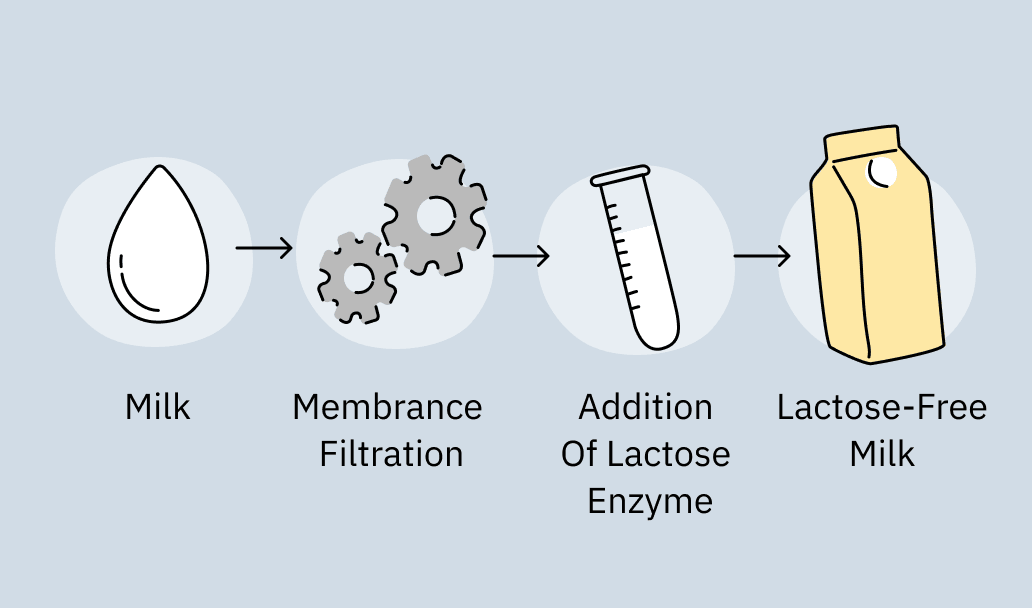Contemporary bars offer all sorts of milk to add to your ordered cup of coffee or bowl of granola. Among other natural alternatives to regular cow milk is lactose-free milk. Why is it becoming more and more popular and is it healthy only for people with lactose intolerance? Let’s find out together.
Lactose, or milk sugar, is a disaccharide in milk and dairy products. The lactose molecule comprises two other molecules, glucose and galactose1M. de Vrese, R. Sieber, M. Stransky. (1998, September). Lactose in human nutrition. Schweizerische Medizinische Wochenschrift. PMID:9783354. This substance determines the sweetness of milk, cream, and butter.
Eat tasty food and lose weight with Unimeal app!
Take a Quiz – Get personal meal plan – Achieve your weight goals!
Start QuizThe traditional way to reduce the amount of lactose in dairy products is fermentation. For example, in the manufacture of fermented milk products or when ripening cheese, lactose naturally breaks down, since when adding a starter culture, bacteria feed on milk sugar.

There are also so-called technological ways to reduce the lactose content in products. The most common way to make lactose-free milk is to carry out membrane filtration and add the lactase enzyme2P. J. T. Dekker, D. Koenders, M. J. Bruins. (2019, March). Lactose-Free Dairy Products: Market Developments, Production, Nutrition and Health Benefits. Nutrients. DOI:10.3390/nu11030551 to the product. The enzyme will break down up to 98% of the lactose in milk.
Lactose-free milk, like ordinary milk, contains a lot of valuable nutrients such as:
Protein - forms muscle tissue and participates in metabolic processes.
Calcium is a building material for bones, teeth, nails, and hair, necessary for blood clotting, proper muscle, and neural reactions.
Potassium - regulates the water balance and normalizes the work of the heart.

Phosphorus - along with calcium and vitamin D, ensures bone strength.
Vitamin D - increases immunity and helps in the assimilation of calcium.
Vitamins of group B - support the nervous system and facilitate the metabolism of proteins, fats, and carbohydrates.
Vitamin A is a "growth" vitamin responsible for visual function, healthy skin, and immunity.

Lactose-free milk is an excellent food product, a source of protein, vitamins, and trace elements. The harm of such a product has not been scientifically proven.
Lactose-free milk is beneficial for children. A growing organism needs the compounds present in dairy products, and such easily digestible milk will not cause problems.

If we talk about the side effects of lactose-free milk, there are very few. In rare cases, it may contain hormones that are given to cows to increase milk production, as well as antibiotics. For this reason, it is essential to buy milk from reliable producers.
In terms of its nutritional properties, it is no different from ordinary cow's milk. Still, unlike it, it is suitable for everyone without causing negative symptoms of gastrointestinal tract disorders.
In terms of taste, lactose-free milk is close to traditional milk, but the split lactose into glucose and galactose acquires a sweeter taste.

Composition | Regular milk | Lactose-free milk |
|---|---|---|
Energy value (kcal) | 46 | 39 |
Proteins (g) | 3,2 | 3,3 |
Carbs (g) | 4,8 | 3,1 |
Lactose (g) | 4,8 | 0,01 |
Fat (g) | 1,5 | 1,5 |
Calcium (mg) | 120 | 120 |

In addition to other advantages, lactose-free milk can significantly diversify your diet. For example, the most popular types of plant-based lactose-free milk include:
Manufacturers often enrich such products with calcium, easily digestible protein, vitamins, prebiotics, and valuable plant extracts4D. Wozniak, W. Cichy , M. Dobrzynska, et al. (2022). Reasonableness of Enriching Cow’s Milk with Vitamins and Minerals. MDPI Open Access Journals. Retrieved from https://www.mdpi.com/2304-8158/11/8/1079/pdf. You can drink it just like that, add it to coffee, tea, pancake batter, porridge, and cereal; prepare milkshakes, puddings, and other vegan desserts.

The main symptoms of lactose intolerance5S. Ugidos-Rodríguez, M. C.Matallana-González, M. C. Sánchez-Mata. (2018, August 15). Lactose Malabsorption and Intolerance: a Review. Food & Function Journal. DOI:10.1039/c8fo00555a, which appear half an hour (sometimes within two hours) after eating a product with lactose, are:
Usually, the doctor establishes the diagnosis of lactose intolerance based on the patient's symptoms. But do not self-diagnose until you visit the therapist.
Lactose-free milk is regular natural milk, only without lactose. It contains vital nutrients, vitamins, and proteins that have a beneficial effect on the human body.
Non-lactose milk is a lifesaver for people with lactase deficiency. So, even if a person has such problems, this is not a reason to refuse dairy products - you can simply replace them with lactose-free ones. Today the market offers a variety of lactose-free products so that you can choose something that explicitly suits your taste!
Unimeal does not diagnose or suggest treatments. Any description of the diet, training plan or supplement should be discussed with your current physician or nutritionist. This article does not address specific conditions and is simply meant to provide general information on healthcare topics. Following any advice is at your own initiative and does not impose any responsibility on the blog authors for your health and safety.
Sources:
By choosing high-quality sources, we make sure that all articles on the Unimeal blog are reliable and trustworthy. Learn more about our editorial processes.
1.
2.
3.
4.
5.